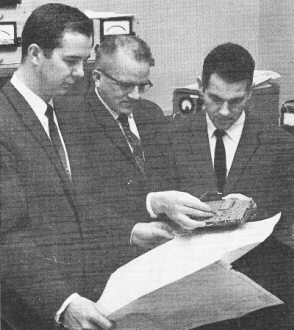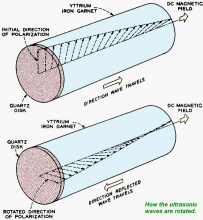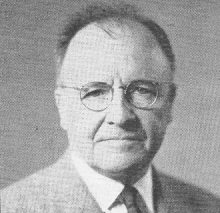News Briefs
|
|
Lots of notable news was breaking in the March 1963 issue of Radio−Electronics magazine. It seems there were some claims of FM radio broadcast licensing Gerrymandering that caused the Federal Communications Commission (FCC) to temporarily halt issuance of new licenses. An unusual report came on having set a record for "remote electronic repair." It involved figuring out why the Telstar satellite would not activate after having spent six weeks in Earth orbit. In what would become standard operational procedure (SOP) for troubleshooting remote outer space probes (both orbiting and interplanetary), engineers used a duplicate Earth-based model of the satellite during diagnosis. Read the piece to discover what was done - pretty ingenious. In other news, people were getting electrocuted in the process of installing and servicing TV antennas in the presence of high voltage electric service lines. Common sense seems to evade some people, removing them from the gene pool. New Briefs: 11/1957 | 8/1958 | 11/1959 | 2/1960 | 4/1960 | 8/1960 | 3/1961 | 5/1961 | 6/1961 | 12/1961 | 3/1963 | 4/1963 | 8/1963 | 9/1963 | 8/1964 | 12/1964 | 1/1967 | 3/1967 | 4/1967 | 9/1967 | 4/1968 News Briefs The repair team: John S. Mayo, left, holds the circuit diagram of the command decoder, while Rebert H. Shennum, center, points out the "zero beat" circuit in the duplicate model held by Henry Mann, right. FM Applications Frozen The Federal Communications Commission has halted all applications for FM stations and changes in existing channels. Its proposed allocation system, based on mileage separations, has provoked severe criticism from supporters of the "protected contour." The commission hopes to resolve these conflicts before acting on the 1,530 FM channels still awaiting assignment. Applications now on file will be kept there. After the ban is lifted, a period for filing new applications will be designated before any new grants are made. The ruling doesn't apply to areas where there are few cities and plenty of space, nor to most educational FM stations. The "freeze" will last only till about June - the FCC hopes. All-Time Record Set for Remote Electronic Repair The most difficult repair job in the history of electronics was successfully completed when Telstar was activated after a 6-week period of silence. The problem was a fantastic one - there was no way of checking the equipment, and the only way to apply remedial measures was to send signals to a nonfunctioning receiver. The repair team had one clue - radiation in part of the satellite's orbit was 100 times as great as had been expected, and the symptoms during the breakdown period indicated possible radiation damage to transistors. A duplicate Telstar was placed in a radiation field similar to that which surrounded the real satellite, and the likelihood of the defect was localized to a probable one out of three transistors. It was also found that removing the radiation gave the transistors an opportunity to recover their original condition, and that especially cutting off the voltage on the back-biased elements of the transistors speeded recovery. A series of "diagnostic signals" was sent, further persuading the Bell Labs scientists that the difficulty was probably in a "zero gate". This was one of two transistors, and passed short pulses, while the other passed long ones, from the transmitters on earth. If the short-pulse gate could be bypassed, it might be possible to send commands to Telstar. An attempt was made to trick the long-pulse gate into recognizing short pulses by sending long dashes with notches in the center. This worked to some extent, and the success with the few commands which the scientists were able to send confirmed the diagnosis. While working further in attempting to construct a command which would cause Telstar to disconnect the storage batteries, a lucky accident, or misinterpretation of the signals received, caused Telstar to turn off its battery. This occurred just before a series of eclipses by the earth, which cut off the power normally supplied by the solar cells, so the transistors received no power at all. The treatment was entirely effective, and both command receivers were returned to use - for how long, the Bell Labs would not venture to predict.
Scientists Herbert Matthews and R. Conway LeCraw report that ultrasonic waves, transmitted down a crystal of yttrium iron garnet, are rotated if a DC magnetic field is applied parallel to the axis of the cylinder, so that the magnetic moments of the iron atoms in the garnet line up parallel to the field. A quartz disk, bonded to one end of the cylinder, was excited with 500-mc pulses, thus generating an ultrasonic wave of the same frequency. As the waves traveled down the cylinder, they were rotated 45° by the magnetic field, and the reflected waves were rotated another 45° in the same direction. This could make a new family of ultrasonic devices possible. The rotation of 90° would make it possible to use the device as an isolator. The reflected waves polarized at 90° could be absorbed by an attenuator without affecting waves traveling at the original zero-degree rotation. Now - The Madistor A new type of semiconductor device has been described by Massachusetts Institute of Technology scientists I. Melngailis and R. H. Rediker. The new member of the semiconductor family uses the effects of a magnetic field on an injection plasma in a semiconductor. The plasma is formed by injecting minority carriers into an indium-antimony semiconductor from the forward-biased junction, and controlling the position of the plasma by small magnetic fields. The action takes place only at low temperatures, experiments having been performed at 77°K. The madistor, by the way, is not another of the names that have grown up around a recent popular magazine, but an acronym for magnetic deflection of an injection plasma produced by saturating traps. TV Masts Plus Power Lines Fatal to 3 Kentuckians Three persons in the same area were killed within a week by contact of a television antenna with a high-tension line. Charles H. Carwile and his son, Staff Sgt. Thomas Carwile, of Hardinsburg, Ky., were fatally shocked when an antenna they were moving from their home touched a high-voltage wire. Four days before, in nearby Somerset, Ky., William Ivan Junglin, 36, a service station owner, was killed when the TV antenna he was installing on his roof brushed against a power line. J. Howard Dellinger, who initiated radio research at the National Bureau of Standards in 1911, died Dec. 28, 1962, at the age of 76. Dr. Dellinger had worked with the NBS from 1907 to 1948, becoming chief of the Radio Section in 1919. After his retirement from NBS in 1948, he continued as a consultant and adviser. Dr. Dellinger was chiefly famous for his discovery of the simultaneous occurrence of solar eruptions and radio disturbances (the Dellinger effect). He was also responsible for initiating the US standard-frequency broadcast service (WWV), carried on studies in radio propagation at high frequencies, and supervised the development of many basic radio aids to air navigation. Author of more than 200 technical papers, Dr. Dellinger was the radio editor of Webster's Dictionary, and a Fellow of the IRE (president in 1925, vice president in 1924).
Posted May 3, 2023 |
|



